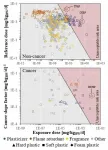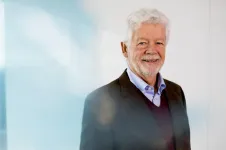Potentially harmful chemicals found in plastic toys
New research suggests that more than 100 chemicals found in plastic toy materials may pose possible health risks to children.
2021-02-22
(Press-News.org) It has long been known that several chemicals used in plastic toys in different parts of the world can be harmful to human health. However, it is difficult for parents to figure out how to avoid plastic toys containing chemicals that may cause possible health risks to their children.
Regulations and labelling schemes are different across regions and countries, and there is no international agreement on which substances should be banned from use in toy materials. For the most part, regulations and international lists of 'chemicals of concern' in toys focus on certain substance groups with known harmful properties, such as phthalates, but do not cover the wider range of chemicals found in plastic toys.
Researchers from DTU and the University of Michigan together with UN Environment have looked into this important issue, analyzed data on chemical functions and amounts found in plastic toys, and quantified related children exposure and potential health risks. They ranked the chemicals according to their health risk and compared these results with existing priority substances lists from around the world. The study has been published with open access in the journal Environment International.
"Out of 419 chemicals found in hard, soft and foam plastic materials used in children toys, we identified 126 substances that can potentially harm children's health either via cancer or non-cancer effects, including 31 plasticizers, 18 flame retardants, and 8 fragrances. Being harmful in our study means that for these chemicals, estimated exposure doses exceed regulatory Reference Doses (RfD) or cancer risks exceed regulatory risk thresholds (all substances in the 'red zone' of below figure). These substances should be prioritized for phase-out in toy materials and replaced with safer and more sustainable alternatives," says Peter Fantke, Professor at DTU Management and the study's principle investigator.
Nicolò Aurisano, the study's first author and Peter's PhD student, explains that toy manufacturers usually do not provide any information on the chemical content in the toys, and toy composition databases are missing. Hence, the researchers had to collect and scrutinize information on chemicals contents in toy materials based on chemical test data for specific toys reported in 25 different peer-reviewed studies.
Nicolò further states: "We have combined the reported chemical content in toy materials with material characteristics and toy use patterns, such as how long a child typically plays with a toy, whether it puts it into the mouth, and how many toys are found in a household per child. We used this information to estimate exposure using high-throughput mass-balance models, and compared exposure doses with doses below which there is no unacceptable risk to the children."
The researchers find that children in Western countries have on average about 18 kilograms of plastic toys, which underlines the large amounts of plastic that children are surrounded by on a daily basis.
Chemicals that the researchers identified to be of possible concern for children's health include, for example, widely known phthalates and brominated flame retardants but also the two plasticizers butyrate TXIB and citrate ATBC, which are used as alternatives to some regulated phthalates.
"These alternatives showed indications for high non-cancer risk potentials in exposed children and should be further assessed to avoid 'regrettable substitutions', where one harmful chemical is replaced with a similarly harmful alternative. Overall, soft plastics cause higher exposure to certain harmful chemicals, and inhalation exposure dominates overall children exposure, because children potentially inhale chemicals diffusing out of all toys in the room, while usually only touching one toy at the time", Peter Fantke explains.
A way toward safe use of chemicals in plastic toys
Many lists exist that inform about 'chemicals of concern' across product and material applications. However, what is currently missing is any information about the levels at which the use of chemicals in the different applications would be safe and sustainable. Here, the researchers introduce a new metric to benchmark chemical contents in toy materials based on exposure and risk.
Peter Fantke explains: "Since the same chemicals can be found in different concentrations across toy materials, we have estimated the 'maximum acceptable chemical content (MACC)' for all the substances reported to be found in plastic toys. Such information will enable decision-makers to develop benchmarks for various chemicals in different applications, but will also help toy companies to evaluate the amount of chemicals used for a specific function against such benchmarks."
As a parent, it will continue to be difficult to avoid using plastic toys that can contain harmful chemicals, until regulators include all substances, and address exposure to toys that are produced outside Europe and imported to the European market. A good piece of advice from the researchers is hence to reduce the consumption of plastic materials in general, avoid the use of soft plastic toys, and remember to ventilate well every day your children's rooms.
INFORMATION:
[Attachments] See images for this press release:

ELSE PRESS RELEASES FROM THIS DATE:
2021-02-22
With the COVID-19 pandemic taking a disproportionate toll on low-income people of color, a research team headed by Marya Gwadz of the Silver School of Social Work at New York University set out to understand the ways the pandemic may put individuals at risk for adverse outcomes, and the ways they successfully adapted to and coped with the emerging pandemic, focused on those from low-socioeconomic status backgrounds who have lived with HIV for a decade or longer.
The team's newly published study explores the effects of COVID-19 on engagement in HIV care, HIV medication use and overall wellbeing during the early stages of the ...
2021-02-22
About 70% of the world's main crops depend on insect pollination. Climate change is already affecting the abundance and distribution of insects, which could cause geographical mismatches between crops and their pollinators. Crops that rely primarily on wild pollinators (e.g., crops that cannot be effectively pollinated by commercial colonies of honey bees) could be particularly in jeopardy. However, limited information on plant-pollinator associations and pollinator distributions complicate the assessment of climate change impacts on specific crops. To study the potential impacts of climate change on pollination of a specific crop in North America, we use the case of open?field ...
2021-02-22
Macrocyclic peptides are promising candidates for pharmaceuticals, but their screening is difficult. Scientists have now developed an easy-to-use, high-throughput screening assay for cyclic peptides with affinity to ubiquitin, a protein that helps to degrade proteins and induce cell death. The results could lead to novel drug candidates against cancer, according to the study published in the journal Angewandte Chemie.
Drugs based on peptides (small proteins) are often too large to pass through cell membranes. To make such peptides more compact and stable--and thus more efficient--researchers are investigating their closed versions, called macrocyclic ...
2021-02-22
This new finding may pave the way for fabricating a new class of self-driven devices and materials, such as the ability to control the rhythmic movement of soft robots without relying on electronic circuits, and for the study of microbial physiology. It has been published in the scientific journal Nature.
A fast growing and interdisciplinary field, active matter science studies systems consist of units where energy is spent locally to generate mechanical work. Active matter includes all living organisms from cells to animals, biopolymers driven by molecular motors, and synthetic self-propelled materials. Self-organisation (the process of producing ordered structures via interaction between ...
2021-02-22
A SARS-CoV-2 tracker uses publicly available sequencing data to show how the virus is changing and spreading over time. The tracker, called CovMT, was developed at KAUST and is expected to help researchers and policymakers understand the evolution of the virus's mutations. This could have implications for vaccine development, patient treatment and the implementation of restrictions.
"As new variants of the SARS-CoV-2 virus emerge, authorities around the world need to know if these, or similar variants, have entered their countries," says computational biologist, Intikhab Alam, who designed ...
2021-02-22
Treating waste brine using a self-cleaning crystallizer that runs on solar power could be an eco-friendly and efficient way to make seawater desalination more sustainable.
In desert regions, seawater desalination provides essential freshwater for drinking and agriculture. A major problem is that the process generates vast quantities of concentrated brine that is often released into nearby lakes and rivers or back into the sea, harming vegetation and marine life. "With tightening environmental regulations and increasing public awareness, there is pressure to treat brine with zero liquid discharge," says Chenlin Zhang, a Ph.D. student in KAUST. This means extracting every last drop of water while leaving behind solid mineral crystals that can be salvaged for other uses.
Crystallization ...
2021-02-22
Monoclonal antibodies are part of the therapeutic arsenal for eliminating cancer cells. Some make use of the immune system to act and belong to a class of treatment called "immunotherapies." But how do these antibodies function within the tumor? And how can we hope to improve their efficacy? Using innovative in vivo imaging approaches, scientists from the Institut Pasteur and Inserm visualized in real time how anti-CD20 antibodies, used to treat B-cell lymphoma, guide the immune system to attack tumor cells. Their findings were published in the journal Science Advances on February 19, 2021
Anti-CD20 antibodies are used in clinical practice to treat patients with B-cell lymphoma, a type of blood cancer. The treatment, often used in combination with chemotherapy, has been ...
2021-02-22
A mixture of smaller countries led by New Zealand, Vietnam, Taiwan, Thailand, Cyprus, Rwanda and Iceland led the world 's Top 10 countries to manage their COVID-19 response well, according to a new study.
In the study, published in The BMJ, lead researcher Flinders University's Professor Fran Baum joined experts from around the world to reflect upon the Global Health Security Index (October 2019) predictions for a public health emergency.
Along with Australia, Latvia and Sri Lanka among the best responders, the list highlights some of the 10 key causes of why some countries were successful or not in containing COVID-19 pandemic over the past year.
The US, UK, Netherlands, Australia, Canada, Thailand, Sweden, Denmark, South Korea, Finland (France, Slovenia and Switzerland) ...
2021-02-22
People with periodontitis are at higher risk of experiencing major cardiovascular events, according to new research from Forsyth Institute and Harvard University scientists and colleagues.
In a longitudinal study published recently in the Journal of Periodontology, Dr. Thomas
Van Dyke, Senior Member of Staff at Forsyth, Dr. Ahmed Tawakol of Massachusetts General Hospital, and their collaborators showed that inflammation associated with active gum disease was predictive of arterial inflammation, which can cause heart attacks, strokes, and other dangerous manifestations of cardiovascular disease.
For ...
2021-02-22
Despite deaths and hospitalisations linked to many new psychoactive substances (NPS), an international wastewater study led by the University of South Australia shows just how prevalent 'party pills' and 'bath salts' are in different parts of the world.
In a new paper published in Water Research, the world's most comprehensive wastewater analysis of NPS shows the pattern of designer drug use in the 2019/2020 New Year in 14 sites across Australia, New Zealand, China, The Netherlands, Spain, Italy, Norway and the United States.
UniSA analytical chemist Dr Richard Bade says samples were collected over the New Year in each country and ...
LAST 30 PRESS RELEASES:
[Press-News.org] Potentially harmful chemicals found in plastic toys
New research suggests that more than 100 chemicals found in plastic toy materials may pose possible health risks to children.




